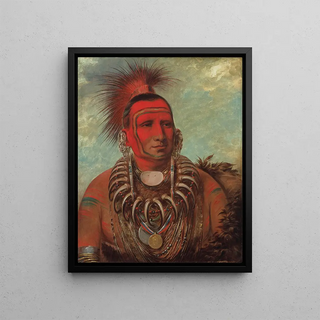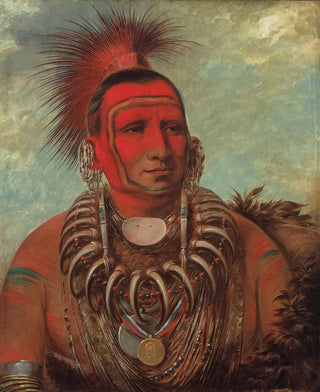Art print | Shon-Ta-Yi-Ga Little Wolf, a famous warrior - George Catlin


View from behind

Frame (optional)
George Catlin's artwork "Shon-Ta-Yi-Ga Petit Loup, a famous warrior" is much more than a simple artistic representation; it embodies the very essence of a culture and an era. As an artist and ethnographer, Catlin dedicated his life to immortalizing the indigenous peoples of North America, capturing their traditions, costumes, and faces with striking accuracy. This painting, both majestic and poignant, immerses us in the world of Native American warriors, bearing witness to a time when respect for traditions and bravery were core values. The art print of this piece not only allows appreciation of Catlin's artistic beauty but also offers a connection to a rich and complex history.
Style and uniqueness of the work
George Catlin's style is distinguished by his ability to blend realism and romanticism. In "Shon-Ta-Yi-Ga Petit Loup, a famous warrior," vibrant colors and meticulous details bring the central character to life, almost emerging from the canvas. The warrior's features, ornaments, and determined gaze reflect a quiet strength and unwavering dignity. Catlin employs a palette of earthy tones, evoking the natural landscapes of the Great Plains and the traditions of the peoples he depicted. The composition, centered on the warrior, immediately draws the eye and invites contemplation. Every element, from the feathers on his headdress to the patterns on his clothing, is loaded with meaning, telling a story that goes beyond the image itself.
The artist and his influence
George Catlin, born in 1796, is often regarded as one of the first artists to document Native American cultures with such depth and passion. His commitment to these peoples led him to travel across the United States, creating portraits and scenes of daily life of the tribes he encountered. Catlin did not merely paint; he was a fervent advocate for the preservation of these cultures in the face of colonial expansion. His work had a significant impact on how Native Americans were perceived.

Matte finish

View from behind

Frame (optional)
George Catlin's artwork "Shon-Ta-Yi-Ga Petit Loup, a famous warrior" is much more than a simple artistic representation; it embodies the very essence of a culture and an era. As an artist and ethnographer, Catlin dedicated his life to immortalizing the indigenous peoples of North America, capturing their traditions, costumes, and faces with striking accuracy. This painting, both majestic and poignant, immerses us in the world of Native American warriors, bearing witness to a time when respect for traditions and bravery were core values. The art print of this piece not only allows appreciation of Catlin's artistic beauty but also offers a connection to a rich and complex history.
Style and uniqueness of the work
George Catlin's style is distinguished by his ability to blend realism and romanticism. In "Shon-Ta-Yi-Ga Petit Loup, a famous warrior," vibrant colors and meticulous details bring the central character to life, almost emerging from the canvas. The warrior's features, ornaments, and determined gaze reflect a quiet strength and unwavering dignity. Catlin employs a palette of earthy tones, evoking the natural landscapes of the Great Plains and the traditions of the peoples he depicted. The composition, centered on the warrior, immediately draws the eye and invites contemplation. Every element, from the feathers on his headdress to the patterns on his clothing, is loaded with meaning, telling a story that goes beyond the image itself.
The artist and his influence
George Catlin, born in 1796, is often regarded as one of the first artists to document Native American cultures with such depth and passion. His commitment to these peoples led him to travel across the United States, creating portraits and scenes of daily life of the tribes he encountered. Catlin did not merely paint; he was a fervent advocate for the preservation of these cultures in the face of colonial expansion. His work had a significant impact on how Native Americans were perceived.






